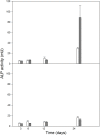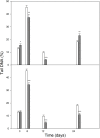Dexamethasone and 1,25-dihydroxyvitamin D3 reduce oxidative stress-related DNA damage in differentiating osteoblasts
- PMID: 25244015
- PMCID: PMC4200756
- DOI: 10.3390/ijms150916649
Dexamethasone and 1,25-dihydroxyvitamin D3 reduce oxidative stress-related DNA damage in differentiating osteoblasts
Abstract
The process of osteoblast differentiation is regulated by several factors, including RUNX2. Recent reports suggest an involvement of RUNX2 in DNA damage response (DDR), which is important due to association of differentiation with oxidative stress. In the present work we explore the influence of two RUNX2 modifiers, dexamethasone (DEX) and 1,25-dihydroxyvitamin D3 (1,25-D3), in DDR in differentiating MC3T3-E1 preosteoblasts challenged by oxidative stress. The process of differentiation was associated with reactive oxygen species (ROS) production and tert-butyl hydroperoxide (TBH) reduced the rate of differentiation. The activity of alkaline phosphatase (ALP), a marker of the process of osteoblasts differentiation, increased in a time-dependent manner and TBH further increased this activity. This may indicate that additional oxidative stress, induced by TBH, may accelerate the differentiation process. The cells displayed changes in the sensitivity to TBH in the course of differentiation. DEX increased ALP activity, but 1,25-D3 had no effect on it. These results suggest that DEX might stimulate the process of preosteoblasts differentiation. Finally, we observed a protective effect of DEX and 1,25-D3 against DNA damage induced by TBH, except the day 24 of differentiation, when DEX increased the extent of TBH-induced DNA damage. We conclude that oxidative stress is associated with osteoblasts differentiation and induce DDR, which may be modulated by RUNX2-modifiers, DEX and 1,25-D3.
Figures






Similar articles
-
Is 1, 25-dihydroxyvitamin D3 an ideal substitute for dexamethasone for inducing osteogenic differentiation of human adipose tissue-derived stromal cells in vitro?Chin Med J (Engl). 2006 Aug 5;119(15):1278-86. Chin Med J (Engl). 2006. PMID: 16919187
-
Dexamethasone induces osteoblast apoptosis through ROS-PI3K/AKT/GSK3β signaling pathway.Biomed Pharmacother. 2019 Feb;110:602-608. doi: 10.1016/j.biopha.2018.11.103. Epub 2018 Dec 8. Biomed Pharmacother. 2019. PMID: 30537677
-
Brief bone morphogenetic protein 2 treatment of glucocorticoid-inhibited MC3T3-E1 osteoblasts rescues commitment-associated cell cycle and mineralization without alteration of Runx2.J Biol Chem. 2003 Nov 7;278(45):44995-5003. doi: 10.1074/jbc.M306730200. Epub 2003 Aug 20. J Biol Chem. 2003. PMID: 12933820
-
Inductive effects of dexamethasone on the gene expression of Cbfa1, Osterix and bone matrix proteins during differentiation of cultured primary rat osteoblasts.J Mol Histol. 2004 Jan;35(1):3-10. doi: 10.1023/b:hijo.0000020883.33256.fe. J Mol Histol. 2004. PMID: 15323344
-
RUNX2: A Master Bone Growth Regulator That May Be Involved in the DNA Damage Response.DNA Cell Biol. 2015 May;34(5):305-15. doi: 10.1089/dna.2014.2688. Epub 2015 Jan 2. DNA Cell Biol. 2015. PMID: 25555110 Review.
Cited by
-
Modular Nanotransporter with P21 Fragment Inhibits DNA Repair after Bleomycin Treatment.Dokl Biochem Biophys. 2018 Mar;479(1):95-97. doi: 10.1134/S1607672918020114. Epub 2018 May 19. Dokl Biochem Biophys. 2018. PMID: 29779106
-
UV Differentially Induces Oxidative Stress, DNA Damage and Apoptosis in BCR-ABL1-Positive Cells Sensitive and Resistant to Imatinib.Int J Mol Sci. 2015 Aug 5;16(8):18111-28. doi: 10.3390/ijms160818111. Int J Mol Sci. 2015. PMID: 26251899 Free PMC article.
-
Dexamethasone-induced production of reactive oxygen species promotes apoptosis via endoplasmic reticulum stress and autophagy in MC3T3-E1 cells.Int J Mol Med. 2018 Apr;41(4):2028-2036. doi: 10.3892/ijmm.2018.3412. Epub 2018 Jan 23. Int J Mol Med. 2018. PMID: 29393368 Free PMC article.
-
Apigenin-7-glycoside prevents LPS-induced acute lung injury via downregulation of oxidative enzyme expression and protein activation through inhibition of MAPK phosphorylation.Int J Mol Sci. 2015 Jan 13;16(1):1736-54. doi: 10.3390/ijms16011736. Int J Mol Sci. 2015. PMID: 25590301 Free PMC article.
References
MeSH terms
Substances
LinkOut - more resources
Full Text Sources
Other Literature Sources

